Derived from cf and risk - Study guides, Class notes & Summaries
Looking for the best study guides, study notes and summaries about Derived from cf and risk? On this page you'll find 46 study documents about Derived from cf and risk.
Page 4 out of 46 results
Sort by
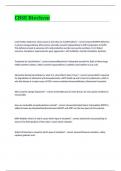
-
CBSE Biochem with correct answers 2023 2024
- Exam (elaborations) • 49 pages • 2023
- Available in package deal
-
- $13.49
- + learn more
CBSE Biochem Lesch-Nyhan Syndrome: what causes it and what are manifestations? - correct answersHGPRT deficiency in purine salvage pathway (this enzyme normally converts hypoxanthine to IMP and guanine to GMP). This deficiency leads to excessive Uric acid production and de novo purine synthesis. It is X linked recessive. Symptoms: hyperuricemia, gout, aggression / self mutilation, mental retardation, dystonia. Treatment for Lesch-Nyhan? - correct answersAllopurinol / febuxostat second ...
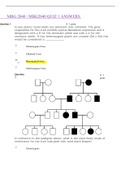
-
MBG 2040 / MBG2040 QUIZ 1 ANSWERS
- Exam (elaborations) • 20 pages • 2022
- Available in package deal
-
- $15.49
- + learn more
MBG 2040 / MBG2040 QUIZ 1 ANSWERS Question 1 0 / 1 point In pea plants round seeds are dominant over wrinkled. The gene responsible for this trait exhibits typical Mendelian expression and is designated with a D for the dominant allele and with a d for the recessive allele. If two heterozygote plants are crossed (Dd x Dd) this would be considered a _ . Homozygous Cross Dihybrid Cross Heterozygous Cross Question 2 0 / 1 point In reference to the pedigree above, what ...

-
University of the Incarnate Word NURS 3312 patho_final_reviews 1,2 and 3 (A+ guide)
- Other • 101 pages • 2022
-
- $10.49
- + learn more
NUR 3125 Exam 1 Review Review cellular components (lysosomes, nucleus, ribosomes, etc.): know function and associated disease if there is deficiencies or abnormal amounts o Plasma Membrane Barrier against external environment Protects organelles (mitochondria, lysosome, nucleus, etc.) Damaged plasma membrane could leave nucleus open which could cause DNA damage Separates ICF from ECF Semi permeable Phospholipid bilayer: allows lipid soluble substances such as oxyge...
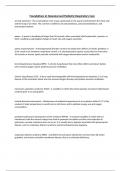
-
Foundations in Neonatal and Pediatric Respiratory Care
- Exam (elaborations) • 29 pages • 2024
-
- $12.49
- + learn more
Foundations in Neonatal and Pediatric Respiratory Care air leak syndrome - the accumulation of air or gas, particularly in the space found between the chest wall and the lung of an infant. The common conditions are pneumothorax, pneumomediastinum, and pneumopericardium. apnea - A pause in breathing of longer than 20 seconds, often associated with bradycardia, cyanosis, or both; resulting in pathological changes in heart rate and oxygen saturation. apnea of prematurity - A developmental di...

-
hesi-final-exam-question-and-answers
- Exam (elaborations) • 75 pages • 2022
-
- $14.49
- + learn more
HESI FINAL EXAM – QUESTION AND ANSWERS HESI FINAL EXAM – QUESTION AND ANSWERS 1. Which of the following signs would indicate to the FNP that a patient might have an airway occlusion and needs assistance? A. Holding throat with both hands B. Coughing C. Crying D. Whispery, soft voice The ability to cough, talk, or cry indicates an incomplete occlusion of the airway. Holding the throat with both hands indicates a complete occlusion (Thomas et al, 2006). *Assessment/E...
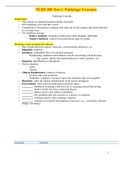
-
NURS 208 Test 1- Pathology Concepts | graded A
- Exam (elaborations) • 47 pages • 2021
-
- $10.99
- 1x sold
- + learn more
Pathology Concepts Homeostasis • The tendency to maintain balance/stability internally • Self-regulating, give-and-take system • Compensatory mechanisms: strategies that make up for the chan ges and return the body to its normal state • Two feedback systems: - Positive feedback: formation of blood clot while bleeding, child birth - Negative feedback: control of elevated blood sugar by insulin Histology: cause or reason for a disease • May include infectious agents, chemicals, environme...
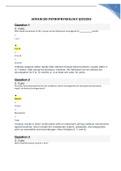
-
Advance patho test, study guide complete test/ADVANCED PATHOPHYSIOLOGY QUIZZES
- Exam (elaborations) • 115 pages • 2023
-
- $17.99
- + learn more
ADVANCED PATHOPHYSIOLOGY QUIZZES After sexual transmission of HIV, a person can be infected yet seronegative for months. 1 to 2 6 to 14 24 to 36 18 to 20 Antibody appears rather rapidly after infection through blood products, usually within 4 to 7 weeks. After sexual transmission, however, the individual can be infected yet seronegative for 6 to 14 months or, in at least one case, for years. Once they have penetrated the first line of defense, which microorganisms do neutr...
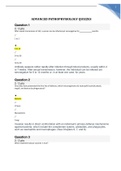
-
Advance patho test, study guide complete test
- Exam (elaborations) • 115 pages • 2023
-
- $18.19
- + learn more
ADVANCED PATHOPHYSIOLOGY QUIZZES After sexual transmission of HIV, a person can be infected yet seronegative for months. 1 to 2 6 to 14 24 to 36 18 to 20 Antibody appears rather rapidly after infection through blood products, usually within 4 to 7 weeks. After sexual transmission, however, the individual can be infected yet seronegative for 6 to 14 months or, in at least one case, for years. Once they have penetrated the first line of defense, which microorganisms do neutr...
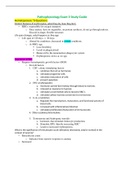
-
NUR 2004 Exam 3 Study Guide.
- Exam (elaborations) • 40 pages • 2021
-
- $10.99
- + learn more
Pathophysiology Exam 3 Study Guide Hematopoiesis ~9 Questions Distinct features of erythrocytes, what they do, how they do it. • RBCs: responsible for oxygen transport. o Once mature, have no or ganelles, no protein synthesis, do not go through mitosis. Discoid in shape, flexible structure. Life span changes, what happens as they age • Life span of 120 days, +- 20 days o Altered by conditions, decreased in certain conditions. o As RBCs age ▪ Lose flexibility ▪ Lysed or phagocytized ▪ R...
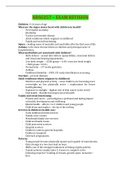
-
NRSG257 – EXAM REVISION
- Exam (elaborations) • 29 pages • 2021
-
- $14.99
- + learn more
NRSG257 – EXAM REVISION Children: 0-14 years of age What are the major issues faced with children in health? - Preventable mortality - Morbidity - Vaccine preventable disease - Adult conditions which originate in childhood - Family and social functioning. Injury – leading cause of mortality and morbidity after the first year of life. Asthma: is the most chronic illness in children and principal cause of hospitalization. What morbidities are associated with children? - Birth defects...

$6.50 for your textbook summary multiplied by 100 fellow students... Do the math: that's a lot of money! Don't be a thief of your own wallet and start uploading yours now. Discover all about earning on Stuvia


